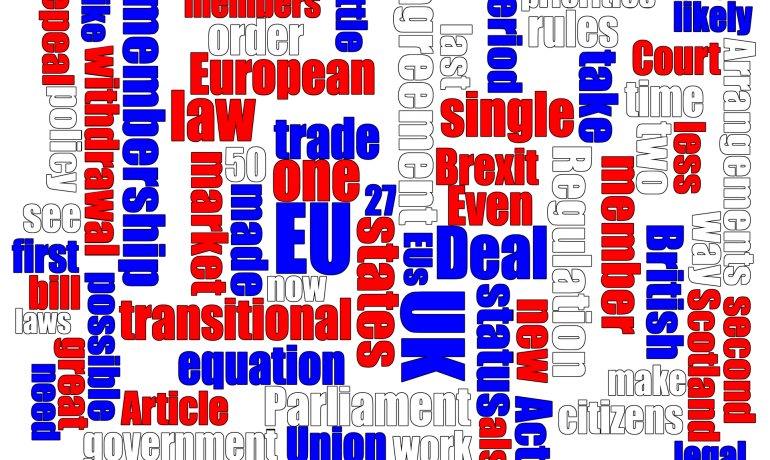With the Conservatives winning an overall majority it now seems likely that Boris Johnson will achieve his objective of “getting Brexit done”, and the UK will presumably leave the EU early in 2020.
The withdrawal agreement agreed in October only covers interim arrangements to avoid the chaos of a No-Deal Brexit. The UK still has to negotiate the permanent trading arrangements with the EU after we leave the Union. These are covered by a 31-page Political Declaration (here), but this is not legally binding, and is open to interpretation, to say the least. Quite how much it is open to interpretation is shown by Part II, Section V of the Withdrawal Agreement, which covers Financial Services in just three paragraphs and is reproduced in its entirety in the box below:
|
37. The Parties are committed to preserving financial stability, market integrity, investor and consumer protection and fair competition, while respecting the Parties’ regulatory and decision-making autonomy, and their ability to take equivalence decisions in their own interest. This is without prejudice to the Parties’ ability to adopt or maintain any measure where necessary for prudential reasons. The Parties agree to engage in close cooperation on regulatory and supervisory matters in international bodies. 38. Noting that both Parties will have equivalence frameworks in place that allow them to declare a third country’s regulatory and supervisory regimes equivalent for relevant purposes, the Parties should start assessing equivalence with respect to each other under these frameworks as soon as possible after the United Kingdom’s withdrawal from the Union, endeavouring to conclude these assessments before the end of June 2020. The Parties will keep their respective equivalence frameworks under review. 39. The Parties agree that close and structured cooperation on regulatory and supervisory matters is in their mutual interest. This cooperation should be grounded in the economic partnership and based on the principles of regulatory autonomy, transparency and stability. It should include transparency and appropriate consultation in the process of adoption, suspension and withdrawal of equivalence decisions, information exchange and consultation on regulatory initiatives and other issues of mutual interest, at both political and technical levels. |
So, plenty of fine words, but what does that actually mean for, say, the future of London as the major financial services hub in the European time zone?
* * * * * *
Here at SAMI Consulting we have been grappling with questions like this for a couple of years now. We don’t pretend to have all the answers, but we have looked atscenarios describing how the UK-EU trading relationship might develop over the next ten years.
One approach we have found particularly useful is to look at other parts of the world, where a smaller country has to co-exist and trade with a larger unified neighbour. Any of the following could be a model for a future UK – EU trade relationship.
Canada – USA
This trading relationship across the longest undefended border in the world is characterised by mutual trust between two countries of comparable levels of wealth. The US benefits from primary resources (lumber, wheat, oil, hydropower); and the Canadian have access to US products and services. Automobile manufacturing, for instance, operates integrated supply chains seamlessly across the border.
But even so, the power is held by USA, as shown by Donald Trump unilaterally restructuring NAFTA. And the US congress would never, for instance, allow Toronto to overtake New York as the primary financial services hub in the Americas time zone.
Mexico – USA
This trading relationship is characterised by an open border for goods; differences in national wealth; migration fears; and mistrust. The power is again held by the USA, as the bigger party. Mexico benefits from access to US markets for lower-cost manufacturing. This trading model is very different from the Canada-US model, and depends on Mexico remaining poorer than the US. Again, it would be difficult to imagine the US permitting Mexico to become the dominant provider of any financial services within the Americas.
Other trading relationships that might act as templates for future UK-EU scenarios are
Each of these six trading relationships could act as a template for future UK-EU scenarios, but they are not all equally likely. Here in SAMI, we have our own views on which of these might appear within the “Cone of Plausibility” (a scenario method described in this document ), but what do you think? Let us know by joining the debate here: ….
Written by Martin Duckworth, SAMI Principal
The views expressed are those of the author(s) and not necessarily of SAMI Consulting.
SAMI Consulting was founded in 1989 by Shell and St Andrews University. They have undertaken scenario planning projects for a wide range of UK and international organisations. Their core skill is providing the link between futures research and strategy.
If you enjoyed this blog from SAMI Consulting, the home of scenario planning, please sign up for our monthly newsletter at newreader@samiconsulting.co.uk and/or browse our website at http://www.samiconsulting.co.uk


